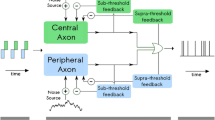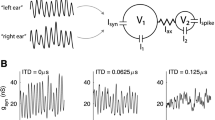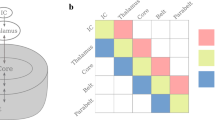Abstract
The cochlear nucleus (CN) presents a unique opportunity for quantitatively studying input-output transformations by neurons because it gives rise to a variety of different response types from a relatively homogeneous input source, the auditory nerve (AN). Particularly interesting among CN neurons are Onset (On) neurons, which have a prominent response to the onset of sustained sounds followed by little or no response in the steady-state. On neurons contrast sharply with their AN inputs, which respond vigorously throughout stimuli. On neurons can entrain to stimuli (firing once per cycle of a periodic stimulus) at up to 1000 Hz, unlike their AN inputs. To understand the mechanisms underlying these response patterns, we tested whether an integrate-to-threshold point-neuron model with a fixed refractory period can account for On discharge patterns for tones, systematically examining the effect of membrane time constant and the number and strength of the exclusively excitatory AN synaptic inputs. To produce both onset responses to high-frequency tone bursts and entrainment to a broad range of low-frequency tones, the model must have a short time constant (≈0.125 ms) and a large number (>100) of weak synaptic inputs, properties that are consistent with the electrical properties and anatomy of On-responding cells. With these parameters, the model acts like a coincidence detector with a threshold-like relationship between the instantaneous discharge rates of the output and the inputs. Onset responses to high-frequency tone bursts result because the threshold effect enhances the initial response of the AN inputs and suppresses their relatively lower sustained response. However, when the model entrains across a broad range of frequencies, it also produces short interspike intervals at the onset of high-frequency tone bursts, a response pattern not found in all types of On neurons. These results show a tradeoff, that may be a general property of many neurons, between following rapid stimulus fluctuations and responding without short interspike intervals at the onset of sustained stimuli.
Similar content being viewed by others
References
Arle J, Kim D (1991) Neural modeling of intrinsic and spikedischarge properties of cochlear nucleus neurons. Biol. Cyber. 64: 273–283.
Banks M, Sachs M (1991) Regularity analysis in a compartmental model of chopper units in the anteroventral cochlear nucleus. J. Neurophys. 65: 606–629.
Blackburn C, Sachs M (1989) Classification of unit types in the anteroventral cochlear nucleus: PST histograms and regularity analysis. J. Neurophys. 62(6): 1303–1329.
Bourk T (1976) Electrical responses of neural units in the anteroventral cochlear nucleus of the cat. Ph.D. dissertation, Massachusetts Institute of Technology.
Brawer J, Morest D, Kane E (1974) The neuronal architecture of the cochlear nucleus of the cat. J. Comp. Neurol. 155: 251–300.
Bregman AS (1990) Auditory Scene Analysis. MIT Press, Cambridge, MA.
Burkitt AN, Clark GM (1999) Analysis of integrate-and-fire neurons: Synchronization of synaptic input and spike output. Neural. Comput. 11(4): 871–901.
Cai Y, Walsh EJ, McGee J (1997) Mechanisms of onset responses in octopus cells of the cochlear nucleus: Implications of a model. J. Neurophys. 78: 872–883.
Cai Y, Walsh EJ, McGee J (2000) Contributions of ionic conductances to the onset responses of octopus cells in the ventral cochlear nucleus. J. Neurophys. 83(1): 301–314.
Cant N (1992) The cochlear nucleus: Neuronal types and their synaptic organization. In: DB Webster, AN Popper, RR Fay, eds., The Mammalian Auditory Pathway: Neuroanatomy. Springer-Verlag, New York. pp. 66–116.
Cant N, Morest D (1979) Organization of the neurons in the anterior division of the anteroventral cochlear nucleus of the cat: Light-microscopic observations. Neuroscience 4: 1909–1923.
Carney L (1993) A model for the responses of low-frequency auditory-nerve fibers in cat. J. Acoust. Soc. Am. 93: 401–417.
Colburn H (1977) Theory of binaural interaction based on auditorynerve data: II. Detection of tones in noise. J. Acoust. Soc. Am. 61: 525–533.
de No RL (1981) The Primary Acoustic Nuclei. Raven Press, New York.
Deutsch D (1982) The Psychology of Music. Academic Press, New York.
Eriksson JL, Robert A (1999) The representation of pure tones and noise in a model of cochlear nucleus neurons. J. Acoust. Soc. Am. 106(4): 1865–1879.
Evans EF (1998) Modeling characteristics of Onset-I cells in guinea pig cochlear nucleus. In: S Greenberg, M Slaney, eds., Proceedings of the NATO Advanced Study Institute on Computational Hearing. Il Ciocco (Tuscany), Italy. pp. 1–6.
Evans EF, Zhao W (1997) Periodicity coding of the fundamental frequency of harmonic complexes: Physiological and pharmacological study of onset units in the ventral cochlear nucleus. In: AR Palmer, A Rees, AQ Summerfield, R Meddis, eds., Psychophysical and Physiological Advances in Hearing. Whurr: London. pp. 186–194.
Frisina R, Smith R, Chamberlain S (1990) Encoding of amplitude modulation in the gerbil cochlear nucleus: I. A hierarchy of enhancement. Hear. Res. 44: 99–122.
Gardner S, Trussell L, Oertel D (1999) Time course and permeation of synaptic AMPA receptors in cochlear nucleus neurons correlate with input. J. Neurosci. 19: 8721–8729.
Godfrey D, Kiang N, Norris B (1975a) Single unit activity in the dorsal cochlear nucleus. J. Comp. Neurol. 162: 269–284.
Godfrey D, Kiang N, Norris B (1975b) Single unit activity in the posteroventral cochlear nucleus. J. Comp. Neurol. 162: 247–268.
Golding NL, Ferragamo MJ, Oertel D (1999) Role of intrinsic conductances underlying responses to transients in octopus cells of the cochlear nucleus. J. Neurosci. 19(8): 2897–2905.
Golding NL, Robertson D, Oertel D (1995) Recordings from slices indicate that octopus cells of the cochlear nucleus detect coincident firing of AN fibers with temporal precision. J. Neurosci. 15: 3138–3153.
Grothe B, Park TJ (1998) Sensitivity to interaural time differences in the medial superior olive of a small mammal, the Mexican freetailed bat. J. Neurosci. 18(16): 6608–6622.
Hill AV (1936) Excitation and accomodation in nerve. Proc. Roy. Soc. (London), Ser. B 119: 305–355.
Isaacson JS, Walmsley B (1996) Amplitude and time course of spontaneous and evoked excitatory postsynaptic currents in bushy cells of the anteroventral cochlear nucleus. J. Neurophys. 76: 1566–1571.
Jiang D, Palmer A, Winter IM (1996) Frequency extent of two-tone facilitation in onset units in the ventral cochlear nucleus. J. Neurophys. 75: 380–395.
Johannesma PIM (1972) The pre-response stimulus ensemble of neurons in the cochlear nucleus. In: Proceedings of the Symposium on Hearing Theory. IPO, Eindhoven, The Netherlands. pp. 58–69.
Johnson D (1980) The relationship between spike rate and synchrony in responses of auditory-nerve fibers to single tones. J. Acoust. Soc. Am. 68(4): 1115–1122.
Johnson D, Swami A (1983) The transmission of signals by auditorynerve fiber discharge patterns. J. Acoust. Soc. Am. 74(2): 493–501.
Joris P, Smith P, Yin T (1994a) Enhancement of neural synchronization in the anteroventral cochlear nucleus. II. Responses in the tuning curve tail. J. Neurophys. 71: 1037–1051.
Joris PX, Carney L, Smith P, Yin T (1994b) Enhancement of neural synchronization in the anteroventral cochlear nucleus: I. Responses to tones at the characteristic frequency. J. Neurophys. 71: 1022–1036.
Kalluri S (2000) Cochlear nucleus onset neurons studied with mathematical models. Ph.D. dissertation, Massachusetts Institute of Technology.
Kalluri S, Delgutte B (1996) A general model of spiking neurons applied to onset responders in the cochlear nucleus. 1996 Computational Neurosciences Conference.
Kalluri S, Delgutte B (1997) An electrical circuit model for cochlear nucleus onset responders. Assoc. Res. Otolaryngol. Abstr. 20: 456.
Kalluri S, Delgutte B(2001) Characteristics of cochlear nucleus onset units studied with a model. In: S Greenberg, M Slaney, eds., Computational Models of Auditory Function. IOS Press, Amsterdam.
Kane EC (1973) Octopus cells in the cochlear nucleus of the cat: Heterotypic synapses upon homeotypic neurons. Intern. J. Neuroscience 5: 251–279.
Kiang N, Morest D, Godfrey D, Guinan J, Kane E (1973) Stimulus coding at caudal levels of the cat's auditory system: I. Response characteristics of single units. In: AR Moller, ed., Basic Mechanisms in Hearing. Academic Press, New York. pp. 455–478.
Kiang N, Watanabe T, Thomas E, Clark L (1965) Discharge Patterns of Single fibers in the Cat's Auditory Nerve. MIT Press, Cambridge, MA.
Kim D, Rhode W, Greenberg S (1986) Responses of cochlear nucleus neurons to speech signals: Neural encoding of pitch, intensity, and other parameters. In: B Moore, R Patterson, eds., Auditory Frequency Selectivity. Plenum Press, New York. pp. 281–288.
Kim DO, Sirianni JG, Chang SO (1990) Responses of DCN-PVCN neurons and auditory nerve fibers in unanesthetized decerebrate cats to AM and pure tones: Analysis with autocorrelation/power spectrum. Hearing Research 45: 95–113.
Kipke DR, Levy KL (1997) Sensitivity of the cochlear nucleus octopus cell to synaptic and membrane properties: A modeling study. J. Acoust. Soc. Am. 102: 403–412.
Levy K, Kipke D (1998) Mechanisms of the cochlear nucleus octopus cell's onset response: Synaptic effectiveness and threshold. J. Acoust. Soc. Am. 103: 1940–1950.
Levy KL, Kipke DR (1997) A computational model of cochlear nucleus octopus cell. J. Acoust. Soc. Am. 102: 391–402.
Liberman MC (1991) Central projections of auditory-nerve fibers of differing spontaneous rate: I. Anteroventral cochlear nucleus. J. Comp. Neurol. 313: 240–258.
Liberman MC (1993) Central projections of auditory-nerve fibers of differing spontaneous rate: II. Posteroventral and dorsal cochlear nucleus. J. Comp. Neurol. 327: 17–36.
Manis P, Marx S (1991) Outward currents in isolated ventral cochlear nucleus neurons. J. Neurosci. 11: 2865–2880.
Marsalek P, Koch C, Maunsell J (1997) On the relationship between synaptic input and spike output jitter in individual neurons. Proc. Natl. Acad. Sci. USA 94(2): 735–740.
Monnier A (1934) L'Excitation Electrique des Tissus. Hermann, Paris.
Morest D, Kiang N, Kane E, Guinan J, Godfrey D (1973) Stimulus coding at caudal levels of the cat's auditory system: II. Patterns of synaptic organization. In: AR Moller, ed., Basic Mechanisms of Hearing. Academic Press, New York. pp. 479–509.
Oertel D (1983) Synaptic responses and electrical properties of cells in brain slices of the mouse anteroventral cochlear nucleus. J. Neurosci. 3: 2043–2053.
Oertel D, Wu SH, Garb M, Dizack C (1990) Morphology and physiology of cells in slice preparations of the posteroventral cochlear nucleus of mice. J. Comp. Neurol. 295: 136–154.
Ostapoff E-M, Feng J, Morest D (1994) A physiological and structural study of neuron types in the cochlear nucleus: II. Neuron types and their structural correlation with response properties. J. Comp. Neurol. 346: 19–42.
Palombi P, Caspari D (1992) GABAa receptor antagonist bicuculline alters response properties of posteroventral cochlear nucleus neurones. J. Neurophys. 67: 738–746.
Pfeiffer R (1966) Classification of response patterns of spike discharges for units in the cochlear nucleus: Tone-burst stimulation. Exp. Brain Res. 1: 220–235.
Rashevsky N (1933) Outline of a physico-mathematical theory of excitation and inhibition. Protoplasma 20: 42–56.
Reyes AD, Rubel EW, Spain WJ (1996) In vitro analysis of optimal stimuli for phase-locking and time-delayed modulation of firing in avian nucleus laminaris neurons. J. Neurosci. 16(3): 993–1007.
Rhode W, Greenberg S (1994) Encoding of amplitude modulation in the cochlear nucleus of the cat. J. Neurophys. 71: 1797–1825.
Rhode W, Oertel D, Smith P (1983) Physiological response properties of cells labeled intracellularly with horseradish peroxidase in cat ventral cochlear nucleus. J. Comp. Neurol. 213: 448–463.
Rhode W, Smith P (1986) Encoding of timing and intensity in the ventral cochlear nucleus of the cat. J. Neurophysiol. 56: 261–286.
Rose J, Brugge J, Anderson D, Hind J (1967) Phase-locked response to low-frequency tones in single auditory nerve fibers of the squirrel monkey. J. Neurophys. 30: 769–793.
Rothman J, Young E, Manis P (1993) Convergence of auditory nerve fibers onto bushy cells in the ventral cochlear nucleus: Implications of a computational model. J. Neurophys. 70: 2562–2583.
Rothman JS, Young ED (1996) Enhancement of neural synchronization in computational models of ventral cochlear nucleus bushy cells. Aud. Neurosci. 2: 47–62.
Rouiller E, Ryugo D (1984) Intracellular marking of physiologically characterized cells in the ventral cochlear nucleus of the cat. J. Comp. Neurol. 225: 167–186.
Shofner WP, Sheft S, Guzman SJ (1996) Responses of ventral cochlear nucleus units in the chinchilla to amplitude modulation by low-frequency, two-tone complexes. J. Acoust. Soc. Am. 99(6), 3592–3605.
Smith P, Rhode W (1987) Characterization of HRP-labeled globular bushy cells in the cat anteroventral cochlear nucleus. J. Comp. Neurol. 266: 360–375.
Smith PH, Rhode WS (1989) Structural and functional properties distinguish two types of multipolar cells in the ventral cochelar nucleus. J. Comp. Neurol. 282: 595–616.
Stevens KN (1995) Applying phonetic knowledge to lexical access. In: Fourth European Conference on Speech Communication and Technology, Vol. 1. Madrid, Spain. pp. 3–11.
Tolbert L, Morest D (1982) The neuronal architecture of the anteroventral cochlear nucleus of the cat in the region of the cochlear nerve root: Golgi and nissl methods. Neuroscience 7: 3013–3030.
Weiss TF (1995) Cellular Biophysics Vol. 2, Electrical Properties. MIT Press, Cambridge, MA.
Westerman L, Smith R (1988) A diffusion model of the transient response of the cochlear inner hair cell synapse. J. Acoust. Soc. Am. 83: 2266–2276.
Winter I, Palmer A (1995) Level dependence of cochlear nucleus onset unit responses and facilitation by second tones or broadband noise. J. Neurophys. 73: 141–159.
Wu S, Oertel D (1984) Intracellular injection with horseradish peroxidase of physiologically characterized stellate and bushy cells in slices of mouse anteroventral cochlear nucleus. J. Neurosci. 4: 1577–1588.
Young E, Robert JM, Shofner W (1988) Regularity and latency of units in ventral cochlear nucleus: Implications for unit classification and generation of response properties. J. Neurophy. 60: 1–29.
Zurek PM (1987) The precedence effect. In:WA Yost, G Gourevitch, eds., Direction Hearing. Springer-Verlag, New York.
Author information
Authors and Affiliations
Rights and permissions
About this article
Cite this article
Kalluri, S., Delgutte, B. Mathematical Models of Cochlear Nucleus Onset Neurons: I. Point Neuron with Many Weak Synaptic Inputs. J Comput Neurosci 14, 71–90 (2003). https://doi.org/10.1023/A:1021128418615
Issue Date:
DOI: https://doi.org/10.1023/A:1021128418615




